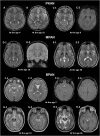Brain MRI Pattern Recognition in Neurodegeneration With Brain Iron Accumulation
- PMID: 33013674
- PMCID: PMC7511538
- DOI: 10.3389/fneur.2020.01024
Brain MRI Pattern Recognition in Neurodegeneration With Brain Iron Accumulation
Abstract
Most neurodegeneration with brain iron accumulation (NBIA) disorders can be distinguished by identifying characteristic changes on magnetic resonance imaging (MRI) in combination with clinical findings. However, a significant number of patients with an NBIA disorder confirmed by genetic testing have MRI features that are atypical for their specific disease. The appearance of specific MRI patterns depends on the stage of the disease and the patient's age at evaluation. MRI interpretation can be challenging because of heterogeneously acquired MRI datasets, individual interpreter bias, and lack of quantitative data. Therefore, optimal acquisition and interpretation of MRI data are needed to better define MRI phenotypes in NBIA disorders. The stepwise approach outlined here may help to identify NBIA disorders and delineate the natural course of MRI-identified changes.
Keywords: NBIA; iron; magnetic resonance imaging; neurodegeneration; pattern.
Copyright © 2020 Lee, Yun, Gregory, Hogarth and Hayflick.
Figures

Similar articles
-
Clinicopathological variability in neurodegeneration with brain iron accumulation.Ideggyogy Sz. 2010 Mar 30;63(3-4):129-35. Ideggyogy Sz. 2010. PMID: 20405671
-
Childhood disorders of neurodegeneration with brain iron accumulation (NBIA).Dev Med Child Neurol. 2011 May;53(5):394-404. doi: 10.1111/j.1469-8749.2011.03955.x. Dev Med Child Neurol. 2011. PMID: 21480873 Review.
-
Neurodegeneration with Brain Iron Accumulation: Clinicoradiological Approach to Diagnosis.J Neuroimaging. 2015 Jul-Aug;25(4):539-51. doi: 10.1111/jon.12195. Epub 2014 Dec 24. J Neuroimaging. 2015. PMID: 25545045 Review.
-
Clinical and Imaging Presentation of a Patient with Beta-Propeller Protein-Associated Neurodegeneration, a Rare and Sporadic form of Neurodegeneration with Brain Iron Accumulation (NBIA).Clin Neuroradiol. 2017 Dec;27(4):481-483. doi: 10.1007/s00062-017-0605-9. Epub 2017 Jun 22. Clin Neuroradiol. 2017. PMID: 28643035
-
Cortical pencil lining on SWI MRI in NBIA and healthy aging.BMC Neurol. 2019 Oct 14;19(1):233. doi: 10.1186/s12883-019-1471-7. BMC Neurol. 2019. PMID: 31607263 Free PMC article.
Cited by
-
Clinical and Molecular Correlates of Abnormal Changes in the Cerebellum and Globus Pallidus in Fragile X Premutation.Front Neurol. 2022 Feb 8;13:797649. doi: 10.3389/fneur.2022.797649. eCollection 2022. Front Neurol. 2022. PMID: 35211082 Free PMC article.
-
Globus Pallidus Lesion With Iron Deposition and Dopaminergic Denervation in a Patient With a Pathogenic SLC6A1 Variant: A Case Report.Neurol Genet. 2024 Mar 19;10(2):e200136. doi: 10.1212/NXG.0000000000200136. eCollection 2024 Apr. Neurol Genet. 2024. PMID: 38515990 Free PMC article.
-
Adult-Onset Genetic Leukoencephalopathies With Movement Disorders.J Mov Disord. 2023 May;16(2):115-132. doi: 10.14802/jmd.22127. Epub 2023 Mar 7. J Mov Disord. 2023. PMID: 36872858 Free PMC article.
-
Antioxidants Prevent Iron Accumulation and Lipid Peroxidation, but Do Not Correct Autophagy Dysfunction or Mitochondrial Bioenergetics in Cellular Models of BPAN.Int J Mol Sci. 2023 Sep 26;24(19):14576. doi: 10.3390/ijms241914576. Int J Mol Sci. 2023. PMID: 37834028 Free PMC article.
-
Biallelic BORCS8 variants cause an infantile-onset neurodegenerative disorder with altered lysosome dynamics.Brain. 2024 May 3;147(5):1751-1767. doi: 10.1093/brain/awad427. Brain. 2024. PMID: 38128568 Free PMC article.
References
Publication types
Grants and funding
LinkOut - more resources
Full Text Sources

